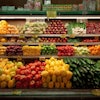
The grocery sector was arguably impacted by the pandemic as hard as any, after sudden panic buying in early 2020 all but cleared shelves overnight, forcing consumer packaged goods (CPG) companies to reevaluate their existing direct-store delivery (DSD) models—if not radically overhaul them—on the fly. From unforeseen spikes in demand for essential items, to supply chain disruptions, to acute shortages of manpower for production and end-to-end logistics, never did so much change, so quickly.
Some three years later, chronic stocking problems persist, as shoppers have grown accustomed to spotty shelves and many of their preferred products typically unavailable. They’re also more mindful than ever of checking sell-by dates of everything, to avoid buying items that are too close to spoilage—within a few days, if not yesterday.
In turn, now is a good time to look at how the DSD model, linking CPGs to local grocery outlets, has so rapidly evolved, and how advanced data-driven solutions can play a lead role in taking it where it still needs to go.
With the inherent constraints surrounding DSD, namely limited space on every delivery truck and variable demand patterns affecting different stores, CPGs must continue looking toward optimized delivery systems. This will help ensure every retail outlet consistently maintains right-sized quantities—or optimal stock position—across every SKU, particularly for perishable foods.
Let’s consider the challenges within a major perishable grocery category -- bread and other baked goods:
- Fresh bread has a relatively shorter shelf life. Major bread companies have typically conceded an intrinsic (or baked-in) return rate of up to 10% of their product as it passes its sell-by dates on store shelves. With the razor-thin margins of grocery products, waste reduction—shrinking that spoilage rate however possible—has become the overarching KPI in this space.
- In this age of instant gratification, where new product categories rapidly redefine the marketplace, bread consumers in particular tend to be quite discerning. Those who aren’t brand-loyal may still be motivated around health-driven options, i.e., whole wheat, organic, non-GMO and so forth. When their preferred choices become chronically understocked at one grocer, they’ll eventually seek them out among competitors. Grocery retailers rely upon the efficiency of DSD-based CPGs to retain both customers and revenue.
- Demand patterns for baked goods are hyperlocal, influenced in large part by consumer demographics and store attributes. Other key variables such as seasonality, holidays, events, price changes, product transitions and new product introductions make it even more complicated to sync day-to-day delivery targets with true, unconstrained consumer demand.
With so many variables in play across the typical DSD model, how can grocery CPGs finally get ahead of unwieldy supply chains and regain efficiency across the delivery process? The answer revolves around artificial intelligence/machine learning (AI/ML) as a foundation of automated predictive ordering. This advanced data science is already enabling grocery CPGs to harness a wealth of tangible data sets to optimize on-shelf availability across every retail outlet, while minimizing waste.
An ideal AI/ML-powered solution encompasses five key facets:
- Automated generation of an unconstrained daily or weekly statistical forecast at a granular product/store level. Statistical baselines are augmented by emerging demand drivers, such as seasonality (in the case of bread, demand for sandwiches during the back-to-school period), retailer promotion schedules, holidays and even localized weather conditions. This daily/weekly time series approach refines granular-level data, reducing any signal-to-noise ratio to determine a precise optimal order forecast for every store delivery, a process we call dynamic aggregation.
- Automatic conversion of those forecasts into optimal/suggested order quantities, leveraging business rules and inherent DSD constraints such as tray rounding, service days, and material availability. These rules and constraints can vary by business, so they should be configurable.
- Capacity to perform exception-based reviews, spanning various dimensions such as customer and route, plus incentivizing drivers’ performance for speed and efficiency. The UI/UX should promote good behavior and help a route operator focus on priority tasks. Let the algorithmic models do the heavy lifting, while humans focus on resolving the occasional exceptions.
- Capability to make late adjustments on-the-fly, based on perpetual inventory recommendations and in-the-field last-minute insights.
- Driving overall business performance by measuring KPIs throughout the lifecycle of the product. Facilitate rapid corrective actions around business decisions or model tuning, ultimately fostering a continuous improvement culture.
The technology behind DSD predictive ordering has already made huge strides, thanks largely to leading-edge AI/ML innovations. Specifically, dynamic aggregation and disaggregation algorithms leveraging cloud-scale computing power are successfully refining enormous volumes of data at a time series level. This ultimately gleans the most actionable data points into what we term the optimal order—or the right-sized quantities for every DSD delivery route. It’s driven by an AI forecast and visibility into components such as base, promotion, seasonality and more.
This data can be directly accessed by delivery drivers and other front-line personnel via a tablet-based user interface, an essential tool for every driver as they efficiently service every stop along their daily delivery routes.


















